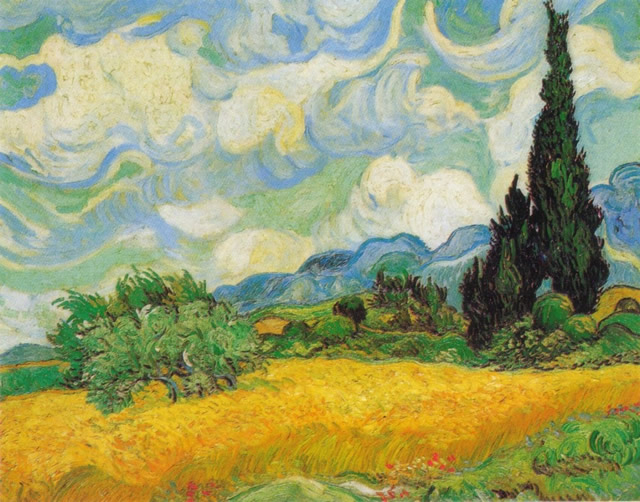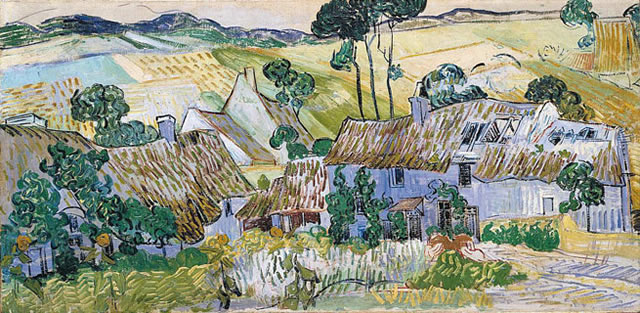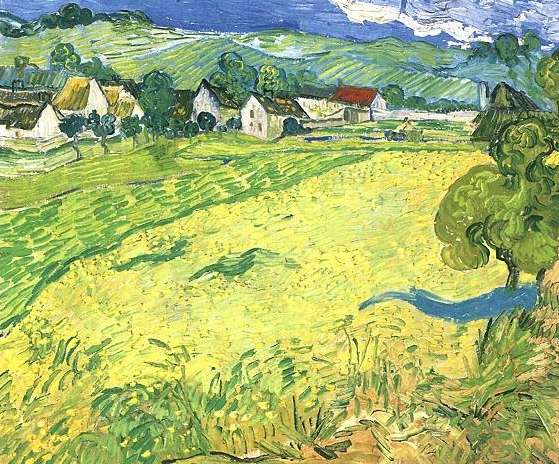Vincent van Gogh
1853 - 1890
Information from The National Gallery

Van Gogh is today one of the most popular of the Post-Impressionist painters, although he was not widely appreciated during his lifetime. He is now famed for the great vitality of his works which are characterised by expressive and emotive use of brilliant colour and energetic application of impastoed paint. The traumas of his life, documented in his letters, have tended to dominate and distort modern perceptions of his art.
Van Gogh was born in Holland, the son of a pastor; he travelled to London in 1873, and first visited Paris in 1874. Over the next decade he was employed in various ways, including as a lay preacher. By 1883 he had started painting, and in 1885-6 he attended the academy in Antwerp where he was impressed by Japanese prints and by the work of Rubens. On his return to Paris in 1886 he met artists such as Degas, Gauguin and Seurat, and as a result lightened the colours he used.
In 1888 Van Gogh settled in Arles in Provence, where he was visited by Gauguin and painted his now famous series of 'Sunflowers'. In the following year a nervous breakdown brought him to a sanatorium at St Remy; it was at this period that he executed 'A Wheatfield, with Cypresses'. In 1890, suffering from a new bout of depression, he shot himself in the chest and died two days later.
A Wheatfield, with Cypresses
1889, Vincent van Gogh

This was painted in September 1889, when Van Gogh was in the St-Rémy mental asylum, near Arles, where he was a patient from May 1889 until May 1890. It is one of three almost identical versions of the composition. Another painting of the cypresses (New York, Metropolitan Museum of Art) was painted earlier in July 1889, and was probably painted directly in front of the subject.
Farms near Auvers
1890, Vincent van Gogh

Van Gogh loved the ‘mossy thatched roofs’ which he saw near his last home at Auvers, close to Paris. A row of dilapidated farm buildings dominates this picture, made a month before the artist’s death.
Their shapes are mimicked by the fields and hills behind. The hasty brushwork and blank sky suggest that the painting is unfinished.
Long Grass with Butterflies
1890, Vincent van Gogh

Van Gogh was a patient at the asylum at St-Rémy, near Arles, from May 1889 to May 1890. During this time he was restricted to working in the asylum's grounds, and shortly after his arrival he described the 'abandoned gardens' in which 'the grass grows tall and unkempt, mixed with all kinds of weeds'. This view of these gardens was painted at the end of the painter's stay at the asylum.
Sunflowers
1888, Vincent van Gogh

This is one of four paintings of sunflowers dating from August and September 1888. Van Gogh intended to decorate Gauguin's room with these paintings in the so-called Yellow House that he rented in Arles in the South of France. He and Gauguin worked there together between October and December 1888.
Van Gogh wrote to his brother Theo in August 1888, 'I am hard at it, painting with the enthusiasm of a Marseillais eating bouillabaisse, which won't surprise you when you know that what I'm at is the painting of some sunflowers. If I carry out this idea there will be a dozen panels. So the whole thing will be a symphony in blue and yellow. I am working at it every morning from sunrise on, for the flowers fade so quickly. I am now on the fourth picture of sunflowers. This fourth one is a bunch of 14 flowers ... it gives a singular effect.'
The dying flowers are built up with thick brushstrokes (impasto). The impasto evokes the texture of the seed-heads. Van Gogh produced a replica of this painting in January 1889, and perhaps another one later in the year. The various versions and replicas remain much debated among Van Gogh scholars.
Van Gogh's Chair
1888, Vincent van Gogh

This work was painted while Van Gogh was working in the company of Gauguin at Arles. It was retouched early in 1889. Van Gogh painted a companion picture of Gauguin's armchair, shown by night, now in the Rijksmuseum Vincent Van Gogh, Amsterdam. The two paintings may have been intended to represent the contrasting temperaments and interests of the two artists.
View of Vessenots near Auvers
May 1890, Vincent van Gogh

During these last few weeks of his life, Van Gogh painted a few portraits but mainly a large number of landscapes among which is "Les Vessenots," the part of Auvers where Dr Gachet -the first owner of this painting- lived. The work is characteristic of Van Gogh's pictorial language at the end of his life, in which he combines very reduced and schematised compositions with a narrow palette of luminous greens and yellows and the use of agitated and nervous brushstrokes which follow a waving and repetitive rhythm. The composition is a horizontal one with a typically raised horizon, grouping together a number of old cottages, some with thatched roofs, alongside extensive fields of wheat and a few waving trees.
Although he always painted in front of the subject, the painting is a very personal vision of the landscape. Van Gogh transformed what he saw into something profoundly personal, giving visual form to the emotions which the landscape in front of him inspired in him. The fertile fields around Auvers produced conflicting feelings within him: the sensation of freedom which he had in front of these broad fields was counterbalanced by melancholy and a sensation of loneliness brought on by the sight of the wheat.
Landscape with Carriage and Train
June 1890, Vincent van Gogh

Vincent wrote about this painting to his mother on June 12, 1890:
"Yesterday in the rain I painted a large landscape, showing fields as far as one can see, looked at from a height, different kinds of green growth, a potato field of a sombre green, between the regular beds the rich violet earth, on one side a field of peas in white bloom, then a field of clover with pink flowers and the little figure of a mower, a field of long and ripe grass somewhat reddish in tone, then various kinds of wheat, poplars, on the horizon a last line of blue hills, along the foot of which a train is passing, leaving behind it an immense trail of white smoke over all the green vegetation. A white road crosses the canvas. On the road a little carriage, and white houses with harshly red roofs by the side of this road."